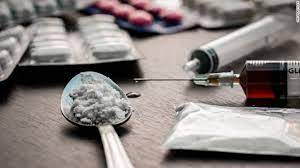Religious centres and educational institutions are assuming a new role in Kashmir by doubling up as counselling and testing centres to curb the fast-spreading menace of drugs. These rare interventions come as the Valley is battling a drug addiction crisis; over 10 lakh people were officially designated drug addicts by the Jammu and Kashmir administration this year.
Dr. Khan addressed a congregation of men and women on the growing menace of drugs and sought the cooperation of parents, especially women, in curbing it. Popular Shia cleric Aga Syed Hadi stayed silent till Dr. Khan completed his awareness-cum-counselling speech.
“On the doomsday, we will be questioned about the role we played to stop youth from getting into this menace. Our mohalla committees and religious scholars need to come together to fight the drug issue,” Mr. Hadi said.
Dr. Khan said the time had come to shift focus to prevention and organise people-centric initiatives. He is putting thrust on engaging women to make de-addiction a community-centric initiative.
“A woman is a mother, wife and daughter. She can assume a greater role in keeping an eye on the children’s activities. If equipped with the know-how of early detection of drug abusers, she can prove to be a real force multiplier against it,” Mr. Khan said, while adding, “Several women in Kashmir wear veils but could be into substance abuse.”
According to data from the Ministry of Social Justice and Empowerment, 1.08 lakh men and 36,000 women were found using cannabis in J&K in 2022; 5.34 lakh men and 8,000 women consumed opioids; 1.6 lakh men and 8,000 women abused sedatives; and 1.27 lakh men and 7,000 women were hooked to inhalants.
“Time demands an organised community response given the scale of the problem. De-addiction exercise has to be brought closer to the community. Mosques are proving to be a pivot for the initiative. Counsellors sharing the pulpit with religious scholars is a golden opportunity to tackle the growing substance abuse,” Dr. Khan told .
The Magam Imambara has also become the Valley’s first religious centre to make screening test kits available for local people.
“If a mother suspects that her son or daughter is into drugs, she can get them screened. We will make women aware about how to identify if the children are into drugs. This will help in early detection and save the families from paying huge money at the de-addiction centres and on the treatment of ailments inflicted by substance abuse,” Dr. Khan said.
Preventive screening of youth is proving to be the key in creating a deterrence. The J&K Police Public School (JKPPS), Bemina, in Srinagar has become the first school in the Valley to implement a drug policy, which puts a thrust on random screening of students annually.
“There were instances reported where students were demotivated in classes and were suspected of getting into drug abuse. We adopted the drug policy last year in the school. Three screening tests (of urine samples) were conducted on students to identify any abuser,” Snigdha Singh, principal of the JKPPS.
In phase two, the school management plans to conduct screening of the staff, including drivers and teachers. “The move has been helpful. Workshops with students and teachers are also being conducted to more informed about the drug problem,” Ms. Singh said.
Dr. Khan is at the forefront of advocating introduction of a drug policy at all schools in Kashmir. “The screening tests will act as a deterrent among students. It may also help bring the society out of denial,” he added.
In another community-centric initiative, youth clubs are being formulated in south Kashmir’s Anantnag district to promote the culture of entertainment as well as conversation among youth after school and college hours. “We have started three such youth clubs. The idea is to identify through peers those who reflect behavioral issues and anti-social traits,” Mudasir Aziz, a clinical psychologist at the Drug Deaddiction Centre, Anantnag, said.
She said childhood disorders were a contributing factor to drug abuse among the youth. “Parenting styles do impact the approach of children. We also counsel the parents on parenting styles. There are higher chances of youth from broken families taking up drugs as a coping mechanism,” Dr. Aziz, who is also engaging with elders in the Bijbehara areas, said.
According to a survey report compiled by Sameena Wani, principal at a government higher secondary in Srinagar, 25% boys and 5.8% girls from high schools and 27% boys and 12.04% girls from higher secondary schools indicated that they knew other students taking some form of drugs. The report was submitted to the government earlier this year to formulate a school-specific drug policy.
#DrugAddiction #Youth #Kashmir #Rehabilitation #Education #Mosques #Awareness #SubstanceAbuse #Prevention #CommunitySupport






